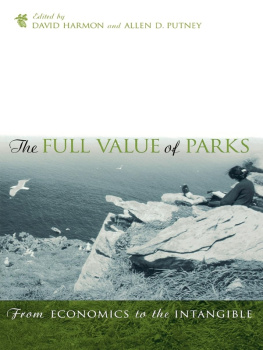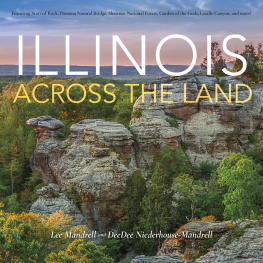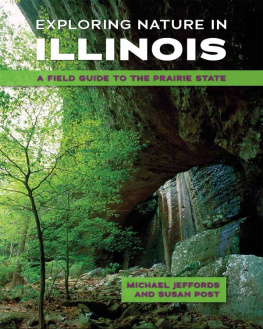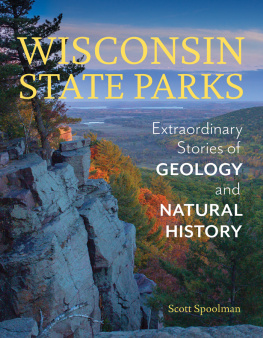Geologists of the Illinois State Geological Survey have been extremely helpful in providing published and unpublished information.
excellent suggestions and careful work.
on many trips to Illinois state parks.
CHAPTER 1 - WHY ILLINOIS STATE PARKS?
Where can we go on vacation this year? When your family asks this question, what do you think ofGrand Canyon, Rocky Mountains, the beach? What if you could experience deep canyons, rugged landscapes, and a dynamic beach, all in Illinois? This book can help you find such places in the Prairie State.
Illinois has bad publicity when it comes to scenery and landscape appreciation. Unfortunately, Illinois Interstate highways traverse some of the flattest land in the state! To appreciate the natural beauty of Illinois, take an exit onto less traveled roads and visit the state parks. Let this book be your guide to the natural beauty of Illinois revealed in its state parks.
Illinois state parks are set aside for recreational and educational benefit of its citizens through private donation or public purchase. Read brochures available at the parks or go to the Department of Natural Resources web page to learn how each came into being. It was the forethought and diligence of individuals and local communities that spared natural sites from the ravages of urban sprawl and random development for private use. The hard work of private citizens, conservation groups, and communities paved the way to preserve many of these beautiful areas for everyone to enjoy. We owe these people a huge Thank you!
State park lands range from historical sites with easy access to wilderness areas accessible only on foot. Illinois has a rich diversity of parks. Guidebooks exist for hikers, plant lovers, bird watchers, wild animal aficionados, amateur historians, and those who love nature in general. There are books that tell the geological story of Illinois in a popular manner (e.g., Wiggers, 1997.) The Illinois State Geological Survey holds geology field trips every fall and spring for the general public. Their guidebooks provide road logs that discuss the route each trip takes, often via back roads to reach interesting features. The ISGS also publishes an excellent resource, Geology of Illinois (Kolata and Nimz, 2010), a large but inexpensive semi-technical volume that discusses all aspects of the fascinating geology of the state.
The book you hold emphasizes the natural, physical settings of geologically significant Illinois state parks. I hope that people will visit these unique and fascinating places as a result of reading this book. Parks are not isolated features on an otherwise drab landscape! The whole landscape is a continuous fabric of information just waiting to be read. Geology provides insights into the states ancient past and dynamic present. This book is designed to assist in reading the land and its parks.
This is not a technical treatise. The goal is to assist individuals and families who visit Illinois parks to better understand our fascinating Earth. Use this book when planning a weekend trip or extended vacation. Few people, even long-time residents of the state, are aware of spectacular features to be enjoyed in Illinois. After visiting some parks, may it not be said, Illinois is flat and boring!
Why do people think Illinois is uninteresting and monotonous?
1. Most Illinois cities are built on ground that is less than totally rugged. Early settlers used rivers and streams for transportation. Rough terrain creates hazards and development problems.
2. Interstate highways are expensive government investments that get us from here to there. Flat landscapes are less expensive and easier to maintain. Some interstates do cut through spectacular scenery, especially in the southern and western parts of the state.
Illinois has parks designed specifically for those who wish to fish, hunt, camp, hike, or just relax. There are historical sites, in addition to those focused more on the natural setting and wildlife. This book is not focused on parks that are mainly recreational and historical. For descriptions for those sites, see the Department of Natural Resources website and brochures at the parks. Our focus is on the physical setting and features in and near more geologically significant parks. These parks often have historical, camping, hunting, hiking, and fishing virtues as well.
To find the best route to a park use a state highway map, atlas, internet mapping tool, Illinois Department of Natural Resources website, or GPS. This book has some suggestions when using interstates to reach parks. Always check before choosing a route to a state park. There is no guarantee of local road quality or construction restrictions. No responsibility is assumed for the accuracy of mileage and location of features described. Natural processes and construction projects alter landscapes. Roads may be rerouted, closed or experience construction, so physical settings may not exactly match descriptions in this book. Check with the Illinois Department of Natural Resources, Illinois Department of Transportation, Illinois Highway Patrol, or other agencies to avoid travel disappointments.
When you arrive at a park, pick up a local brochure, which gives lots of information, its history, accommodations and trails. Individuals are responsible for their own safety when visiting a park. Avoid hazards such as loose rocks, steep slopes, cliffs, water bodies, vehicle traffic, venomous reptiles, etc. Watch where you step. Never trespass on private or state property closed to the public without prior authorization. Dont collect anything from state parks! Leave no trash. Wear appropriate clothing. Avoid areas where you might become disoriented or lost. Do not read descriptions as you drive. Have another person read while you drive! If you use your odometer to follow descriptions in this book, realize that odometers are not uniform and may not match printed mileages.
For additional information, see the reference section. I owe a great debt to the Illinois State Geological Survey for their excellent field guides, as well as technical literature which served as background for writing this book. At the head of each region or park description are references from which much of the information was gathered. For more detailed descriptions, see those references. Geologists at the ISGS have been very helpful, providing information not readily available in print.
Nature can be appreciated in many ways. For some it is like an artist viewing a canvas of color and light. For others nature is a book written by God and a source of inspiration and worship. For some the Earth is a wonder of experiences of sight, touch and smell. As you view landscapes through the lens of this book, you may sense all of these as you learn how the many features in the parks came to be. Talk about what you see with your fellow travelers. Enjoy!
Although not a technical book, there are terms that help move the discussion along. Some are in bold . Most are described as they are introduced and defined in the Glossary.
Parks and Sites Described in this Book
Apple River Canyon State Park
Buffalo Rock State Park
Castle Rock State Park
Cave-In-Rock State Park
Chain-O-Lakes State Park
Dixon Springs State Park
Ferne Clyffe State Park
Fox Ridge State Park






